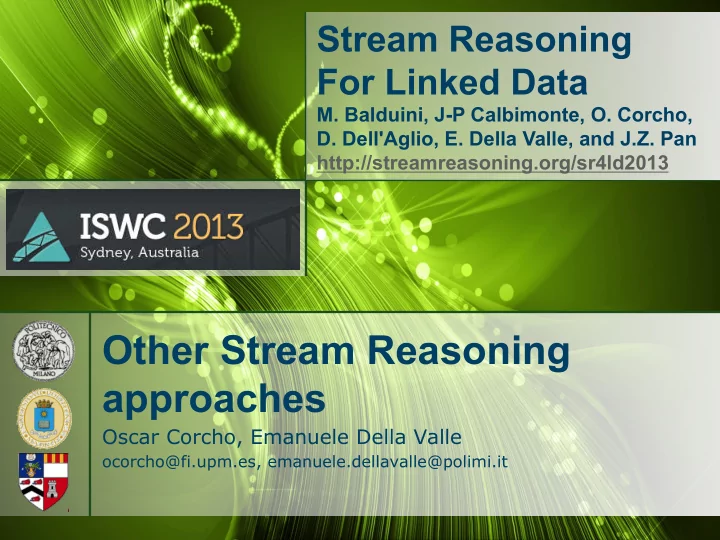

Stream Reasoning For Linked Data M. Balduini, J-P Calbimonte, O. Corcho, D. Dell'Aglio, E. Della Valle, and J.Z. Pan http://streamreasoning.org/sr4ld2013 Other Stream Reasoning approaches Oscar Corcho, Emanuele Della Valle ocorcho@fi.upm.es, emanuele.dellavalle@polimi.it
Share, Remix, Reuse — Legally ! This work is licensed under the Creative Commons Attribution 3.0 Unported License. ! You are free: • to Share — to copy, distribute and transmit the work • to Remix — to adapt the work ! Under the following conditions • Attribution — You must attribute the work by inserting – � [source http://streamreasoning.org/sr4ld2013] �� at the end of each reused slide – a credits slide stating - These slides are partially based on � Streaming Reasoning for Linked Data 2013 �� by M. Balduini, J-P Calbimonte, O. Corcho, D. Dell'Aglio, E. Della Valle, and J.Z. Pan http://streamreasoning.org/sr4ld2013 ! To view a copy of this license, visit http://creativecommons.org/licenses/by/3.0/ 2 http://streamreasoning.org/sr4ld2013
Agenda ! ETALIS and EP-SPARQL • A Declarative Framework for Matching Iterative and Aggregative Patterns against Event Streams – Darko Anicic, Sebastian Rudolph, Paul Fodor, Nenad Stojanovic 3 http://streamreasoning.org/sr4ld2013
Iterative and Aggregative Patterns in ETALIS ETALIS Features: Recursive CEP in ETALIS • Logic-based CEP Event Sources • Stream (deductive) reasoning Detected Situations • Iterative and aggregative patterns CEP • Implementation • http://code.google.com/ Pattern p/etalis Definitions http://streamreasoning.org/sr4ld2013 4
ETALIS - A Logic Rule-based CEP ! Iterative patterns • An output (complex) event is treated as an input event of the same CEP processing agent; ! A rule-based approach • Rules can express complex relationships between events by matching certain temporal , relational or causal conditions • It can specify and evaluate contextual knowledge http://streamreasoning.org/sr4ld2013
ETALIS: Language Syntax ETALIS Language for Events is formally defined by: • pr - a predicate name with arity n; • t (i) - denote terms; • t - is a term of type boolean; • q - is a nonnegative rational number; • BIN - is one of the binary operators: SEQ, AND, PAR, OR, EQUALS, MEETS, STARTS, or FINISHES. Event rule is defined as a formula of the following shape: where p is an event pattern containing all variables occurring in http://streamreasoning.org/sr4ld2013
ETALIS: Interval-based Semantics http://streamreasoning.org/sr4ld2013
ETALIS: Declarative Semantics http://streamreasoning.org/sr4ld2013
EP-SPARQL (I) ! Basics • SPARQL extension (as with other previously seen languages) • Interval-based: 2 timestamps ! Operators • FILTER, AND, UNION, OPTIONAL, SEQ, EQUALS, OPTIONALSEQ, and EQUALSOPTIONAL – Be careful with the management of timestamps (see next) – E.g., ! Special functions • getDuration(), getStartTime(), getEndTime() 9 http://streamreasoning.org/sr4ld2013
EP-SPARQL (II) ! Sequence operators and CEP world e 4 S e 1 e 2 e 3 1 3 6 9 Sequence Simultaneous ! SEQ: joins e ti,tf and e’ ti’,tf’ if e’ occurs after e ! EQUALS: joins e ti,tf and e’ ti’,tf’ if they occur simultaneously ! OPTIONALSEQ, OPTIONALEQUALS: Optional join variants Prolog continuous EP-SPARQL translator engine results query http://streamreasoning.org/sr4ld2013
EP-SPARQL Example 11 http://streamreasoning.org/sr4ld2013 11
EP-SPARQL sample translation (SEQ) http://streamreasoning.org/sr4ld2013 12
Stream Reasoning For Linked Data M. Balduini, J-P Calbimonte, O. Corcho, D. Dell'Aglio, E. Della Valle, and J.Z. Pan http://streamreasoning.org/sr4ld2013 Other Stream Reasoning approaches Oscar Corcho, Emanuele Della Valle ocorcho@fi.upm.es, emanuele.dellavalle@polimi.it
Recommend
More recommend